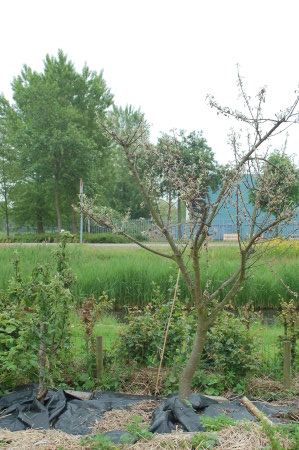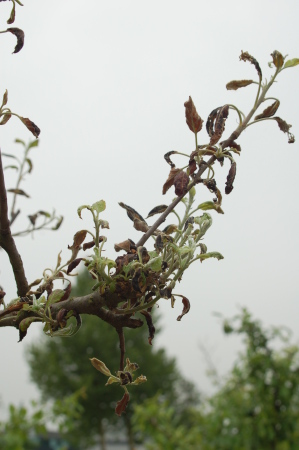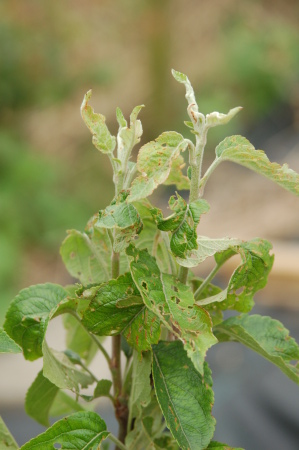
Does anyone have any idea what might be wrong with the apple tree on the right in the picture above? I’m sorry because of the background it’s hard to see, but it looks like it’s almost dead.
Here’s a close up of one of the branches. You can see the leaves have almost completely turned brown.

Below is a close up of the smaller apple tree on the left, and while it looks a lot healthier, perhaps it has an infection of some sort? Small brown spots and slightly withering leaves? Maybe it’s the same thing that is causing the problem with the almost dead looking tree?
The smaller, healthier looking tree on the left is the same tree I posted about several days ago that has the canker infection.

Here’s a little more information about the tree on the right:
Last year it produced apples, but after they were about 2cm in diameter they turned brown and fell off the tree. This year it didn’t set any fruit, but it did bloom.
I plan to remove the tree anyway, because it’s too close to the tree next to it (about 1m away) and it’s in the wrong part of the garden. Mostly I’m interested in understanding what’s happening. I’m pretty sure it’s the only pollinator available for the tree on the left, so I can’t remove it until I replace it with another tree of the same flowering period, or I won’t get any apples on the remaining tree.
The ground in this part of the garden is very poor and on the wet side, and the previous gardener was keeping these fruit trees alive with chemical fertilizer which I’ve stopped using. I did put quite a bit of compost around these trees this year. The previous gardener never pruned his trees, but I have been pruning them for the last 2 years since I’ve had this garden. I’ve planted some nitrogen fixing trees nearby, but they are too young and haven’t had a chance to fix any nitrogen yet. I also removed a nearby tree over the winter, so this tree has a little more space than it had last year.
The pH in my garden is mostly 6-6.5, and I did give these trees a few handfulls of lime this spring. While I don’t know exactly what the pH is here, it’s probably close enough to being right for apple trees.


My dad has two apple trees in his front yard. I think he planted them before I was born. For decades he’s pruned them and tries everything he can. They always flower like crazy and set tons of apples, which mostly get eaten by the squirrels before they are golf ball size. I think I rememebr eating one apple a very very long time ago. Maybe you have a better use for the space than the apple trees. I certainly don’t know what the secret is, if there is one.
fireblight?
I fear you may be right Madeline (you too Lzyjo).
I was certainly hoping to find out it was something a little less contagious! Next time I get to the garden, I’ll have a closer look at the other trees.
I have no guess about the problem. However, for a pollinator I do suggest getting a crabapple. From what I’ve read, crabapples are the best apple pollinators because they have a longer bloom period and apples are supposedly so time specific that unless you have a number of trees of the same species it’s almost impossible to get them to fruit. I don’t know this first hand, just from online research.
Looks like some sort of blight to me too. 🙁
It’s hard to tell, it could be ‘perevuur’, I don’t know if fireblight is the English word for that, erwinia amylovora…If you can see on infected, but still green branches some sort of brownish dried up ‘sap-drops’ (certainly on the smaller tops of the branches) it’s perevuur, but otherwise I would go for a leucostoma infection…But I had to take my apple-disease book here, so I’m only judging things based on this information, not on my experiences…
Thanks everyone. Yes Frank, I understand fireblight is a more serious problem for pear trees, which is kind of interesting because my pear tree is doing fine. It’s nice to know the Dutch word, thanks. In fact, I don’t really see significant signs of infection in any other tree.
I cut the tree down the other day, and I could see the wood itself was infected too, all the way through the tree. If I had left it, it’s doubtful it would have survived much longer.
I also think it is fire blight. It is common here in San Francisco CA. When I had my gardening business I often had to deal with it. It was often spread from pruning equipment. It is extremely important to clean your pruning blade after each cut with a bleach solution. You will spread it to other fruit trees, especially pears and apricots and also to roses. What was helpful for me; if the branches were small I would just prune them back to the next set of green healthy leaves. If the branches were large I would trim the fire blight infested leaves off, regularly and in the fall prune heavily. Apples seem to tolerate fire blight much better then pears which seem to die from i., Apricots will look awful but still bear fruit and survive. Hope this helps.
Hi Eileen,
Thanks for all the suggestions — especially cleaning of pruning equipment. I wouldn’t have thought of that, but I can see why that would be important!